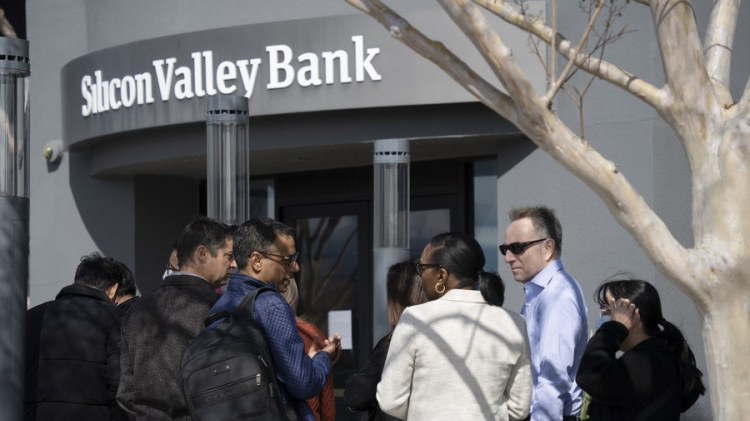
People queue up outside the headquarters of the Silicon Valley Bank (SVB) in Santa Clara, California, the United States, March 13, 2023. /Xinhua)
People queue up outside the headquarters of the Silicon Valley Bank (SVB) in Santa Clara, California, the United States, March 13, 2023. /Xinhua)
Editor's note: Wang Zhenxia is an associate researcher at the National Academy of Economic Strategy, Chinese Academy of Social Sciences, and director of the editorial department for Finance & Trade Economics. The article reflects the author's opinion, and not necessarily the views of CGTN.
The bankruptcy of the Silicon Valley Bank has captured the attention of major countries and regions around the world. Researchers have reached a consensus on the causes and potential consequences of the bankruptcy: It is the outcome of a dim outlook for tech company investments amid the U.S. Federal Reserve's interest rate hikes, coupled with a maturity mismatch between the bank's assets and liabilities. Given the recent decisive actions taken by the Federal Reserve and U.S. Treasury Department, the bankruptcy is unlikely a result in systemic financial risks in the United States or globally in the short term.
It's worth noting that the true impact of the Silicon Valley Bank's bankruptcy are twofold: The recurring occurrence of severe financial risks in Western countries, exemplified by the U.S, has a negative impact on global market expectations and the world's economic rebound. Additionally, it prompts reflection over the effectiveness of the current macroeconomic policies.
In an era of slowing technological progress and declining total factor productivity, fostering growth of the virtual economy through financial innovation, while bypassing supervision and regulation, has become commonplace in developed countries such as the United States. Inflation, which comes with irrational exuberance, poses a historical challenge for macroeconomic regulators.
For a long time, many economists and central bank officials in developed countries, including the U.S., did not believe that monetary policy could tame inflation. Accordingly, the monetarist proposal of stabilizing the money supply was not embraced by policymakers.
On the one hand, post-World War II price trends in major countries were stable, and economic growth was robust; on the other hand, the collapse of the Bretton Woods system led to tighter connections between global financial markets, and the impact of international markets on a single country's money supply became more evident, making the policies advocated by monetarism even more difficult to implement.
Can macroeconomic policies effectively intervene in the formation and trajectory of inflation? Do policy tools eliminate inflation, or merely delay its burst, or even contribute to its occurrence? Under what conditions will inflation lead to welfare losses? In comparison to the decline in real wage levels, are longer working hours and heavier workloads also a manifestation of inflation? These questions have yet to be adequately addressed by mainstream macroeconomic theories.

A man walks past the U.S. Federal Reserve in Washington, D.C., the United States, on March 16, 2022. /Xinhua
A man walks past the U.S. Federal Reserve in Washington, D.C., the United States, on March 16, 2022. /Xinhua
The outbreak of "stagflation" in the 1970s led to more nuanced understanding of inflation among macroeconomic regulators. Stabilizing the money supply through policy tools like interest rate adjustments became the mainstream view. Nonetheless, policies aimed at stabilizing the money supply often encounter real-world challenges, particularly the damage that sluggish economic growth inflicts on employment and welfare.
Specifically, when domestic economic growth lacks endogenous momentum, conventional policy measures are incapable of substantially improving growth levels. Influenced by economic liberalization ideas, "irrational exuberance" spurred by financial innovation has become the primary driver of economic growth in developed countries such as the U.S. It can be argued that the difficulty in striking a balance between growth and stability is the main reason behind the frequent financial crises in the United States in recent years.
It's evident that even if the bankruptcy of Silicon Valley Bank does not set off a chain reaction or result in systemic financial risks, the regulatory challenges faced by the U.S. and other developed countries are unlikely to be resolved in the short term. The global implications of this event underscore the urgent need to rethink the fundamental issues of macroeconomic theory through innovative theoretical research.
By incorporating long-term factors such as institutional frameworks into the scope of study and seriously reflecting on the role of modern financial development, this research can guide policy formulation in practice.
The bankruptcy process of the Silicon Valley Bank demonstrates that banks do deviate from its traditional business scope. Instead of being a stabilizer for the real economy, it becomes a factor of instability in the economic system. Meanwhile, it also reflects the characteristics of the large scale of the U.S. monetary policy adjustment, the lack of policy focus, and the failure to guide market expectations. The way to deal with crises is mainly an emergency response, which cannot prevent the possible "moral hazard" problem. This is not only the lack of theoretical research, but the dilemma of policy formulation and implementation.
Under the current system, the "black swan" and "gray rhinoceros" events may erupt frequently and there is no good way to resolve them. The financial system is far more complex than imagined, with the potential of the collapse of super-financial institutions, as well as a chain reaction of smaller institutions. We should ask: How to promote economic growth while ensuring security; How to provide regulatory foresight and improve response capacity in times of crises will become urgent issues to be solved?
(If you want to contribute and have specific expertise, please contact us at opinions@cgtn.com. Follow @thouse_opinions on Twitter to discover the latest commentaries in the CGTN Opinion Section.)